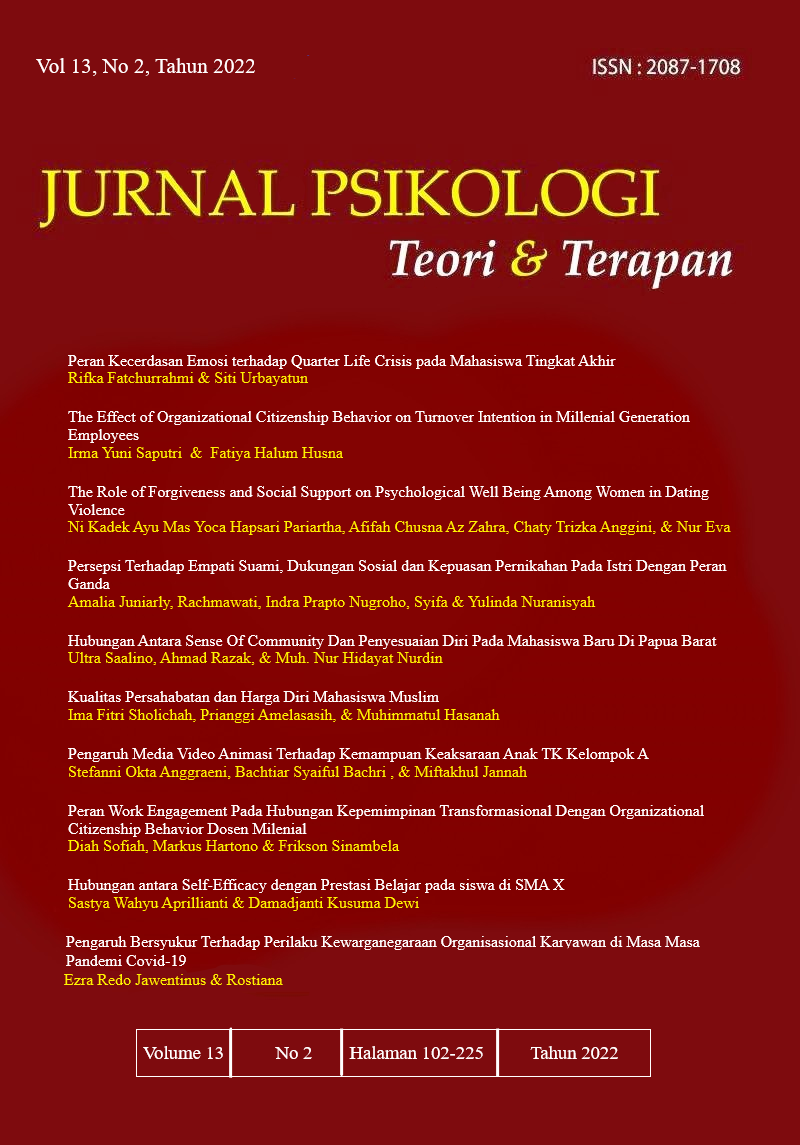Hubungan antara Self-Efficacy dengan Prestasi Belajar Siswa di SMA X
DOI:
https://doi.org/10.26740/jptt.v13n2.p195-213Keywords:
Self-Efficacy, Prestasi Belajar, Matematika, Siswa, Academic Achievement, Mathematics, StudentsAbstract
Abstract: Online learning has an impact on students learning process, one of which is mathematics achievement. Mathematics is identical to a difficult subject because the many formulas, calculation, and requires good logical thinking. Some studies mention the impact of academic achievement during pandemic has decreased, but several other studies have also shown an increase in academic achievement during pandemic. The existence of inconsistencies in previous studies, make researcher want to examine more deeply related to academic achievement in terms of students’ self-efficacy during pandemic, The purpose of the study was to determine the relationship between self-efficacy and student achievement in SMA X. The research subjects used were the entire population of class XI students at SMA X with totaling 158 students. The method used is a correlational quantitative method. The measuring instrument used in this study use an adaptation of Gaumer and Noonan (2018) self-efficacy scale, namely the the Self-Efficacy Formative Questionnaire, while the academic achievement variable is measured using the student’s math score index of class XI students in the even semester of 2020/21 school year. The data analysis technique used in this study used pearson correlation SPSS 25.0 for windows with a correlation result of 0.342 (r>0.05) and a significance value of 0.000 (p<0.05). The result of this study indicate that there is a positive and significant relationship between self-efficacy and academic achievement with a weak degree of relationship. Self-efficacy also has an important role as a variable that can increase academic achievement, especially during the pandemic by using online learning methods.
Abstrak: Pembelajaran daring memberikan dampak terhadap proses belajar siswa, salah satunya prestasi belajar matematika. Matematika identik dengan pelajaran yang sulit karena banyaknya rumus, hitungan, serta membutuhkan logika berpikir yang cakap. Beberapa penelitian menyebutkan dampak prestasi belajar selama masa pandemi mengalami penurunan, namun beberapa penelitian lain juga menunjukkan adanya peningkatan prestasi belajar selama pandemi. Adanya inkonsistensi dalam penelitian terdahulu membuat peneliti ini ingin meneliti lebih dalam terkait prestasi belajar siswa ditinjau dari self-efficacy siswa selama masa pandemi. Tujuan dilakukannya penelitian untuk mengetahui hubungan antara self-efficacy dengan prestasi belajar pada siswa di SMA X. Subjek penelitian yang digunakan adalah seluruh populasi siswa kelas XI di SMA X sejumlah 158 siswa. Metode yang digunakan adalah metode kuantitatif korelasional. Alat ukur yang digunakan penelitian ini menggunakan adaptasi skala self-efficacy milik Gaumer dan Noonan (2018) yaitu Self-Efficacy Formative Questionnaire, sedangkan variabel prestasi belajar diukur dengan menggunakan indeks nilai matematika siswa kelas XI semester genap tahun ajaran 2021/2021. Teknik analisa data penelitian ini menggunakan pearson correlation SPSS 25.0 for windows dengan hasil korelasi sebesar 0.342 (r>0.05) serta nilai signifikansi sebesar 0.000 (p<0.05). Hasil dari penelitian yang dilakukan menunjukkan bahwa terdapat hubungan yang positif serta signifikan antara self-efficacy dan prestasi belajar dengan derajat hubungan yang lemah. Self-efficacy juga memiliki peranan penting sebagai variabel yang mampu meningkatkan prestasi belajar, khususnya di masa pandemi dengan menggunakan metode pembelajaran daring.
References
Azwar, S. (2017). Metode Penelitian Psikologi. Pustaka Belajar.
Bandura, A. (1997). Self-Efficacy: The Exercise of Control. W.H Freeman and Company.
Gaumer, E. A. ., Soukup, J. ., Noonan, P. ., & McGurn, L. (2018). Self-Efficacy Formative Questionnaire Technical Report Overview. In Research Collaboration (Vol. 1). http://www.researchcollaboration.org/uploads/Self-EfficacyQuestionnaireInfo.pdf
Gaumer, E. A. S., & Noonan, P. M. (2018). Self-efficacy formative questionnaire. In The skills that matter: Teaching interpersonal and intrapersonal competencies in any classroom. Corwin. https://doi.org/http://dx.doi.org/10.4135/9781506376349
Ghufron, M. ., & Risnawita, R. (2010). Teori-Teori Psikologi. Ar-Ruzz Media.
Jannah, M. (2018). Metodologi Penelitian Kuantitatif untuk Psikologi. UNESA University Press.
Kaplan, R. M., & Saccuzzo, D. P. (2012). Pengukuran Psikologi Prinsip, Penerapan, dan Isu (7th ed.). Salemba Humanika.
Khurriyati, Y., Setiawan, F., & Mirnawati, L. B. (2021). Dampak pembelajaran daring terhadap hasil belajar siswa Mi Muhammadiyah 5 Surabaya. Jurnal Ilmiah Pendidikan Dasar, 8(1), 91. https://doi.org/10.30659/pendas.8.1.91-104
Komara, I. B. (2016). Hubungan antara kepercayaan diri dengan prestasi belajar dan perencanaan karir siswa SMP. PSIKOPEDAGOGIA Jurnal Bimbingan Dan Konseling, 5(1), 33. https://doi.org/10.12928/psikopedagogia.v5i1.4474
Lopez, S. J., & Synder, C. R. (2003). Positive Psychological Assesment a Handbook of Models and Measurements. American Psychological Association. https://doi.org/https:// https://doi.org/10.1037/10612-000 apa.org
Myers, D. . (2002). Social Psychology (7th ed.). McGraw-Hill.
Slameto. (2010). Belajar dan Faktor-Faktor yang Mempengaruhinya (Ed.Rev., C). PT. Rineka Cipta.
Sugiyono. (2017). Metode Penelitian Pendidikan: Pendekatan Kuantitatif, Kualitatif, dan R&D. Alfa Beta.
Sugiyono. (2018). Metode Penelitian Kuantitatif. Alfa Beta.
Syah, M. (2010). Psikologi Pendidikan. PT. Raja Grafindo Persada.
Ulandari, S. S. ., Dibia, I. K., Sudana, & Nyoman, D. (2014). Hubungan antara motivasi belajar dengan prestasi belajar siswa SD Kelas V semester ganjil di Desa Buruan. Jurnal Mimbar PGSD Uniiversitas Pendidikan Ganesha, 2(1). https://doi.org/http://dx.doi.org/10.23887/jjpgsd.v2i1.2312
Winkel, S. (2014). Psikologi Pengajaran. Sketsa.
Downloads
Published
How to Cite
Issue
Section
License

This work is licensed under a Creative Commons Attribution-NonCommercial 4.0 International License.
Authors who publish in this journal agree to the following terms:
Copyright in any article is held by the author.
The author grants the journal, publication rights with the work simultaneously licensed under a Creative Commons Attribution License that allows others to share the work with an acknowledgment of the work's authorship and initial publication in this journal.
Authors may enter into separate, additional contractual arrangements for the non-exclusive distribution of the journal's published version of the work (e.g., posting it to an institutional repository or publishing it in a book), with an acknowledgment of its initial publication in this journal.
Authors are permitted and encouraged to post their work online (e.g., in an institutional repository or on their website) prior to and during the submission process, as this can lead to productive exchanges, as well as earlier and greater citation of published work.
 Abstract views: 3729
,
Abstract views: 3729
, PDF Downloads: 3208
PDF Downloads: 3208


















